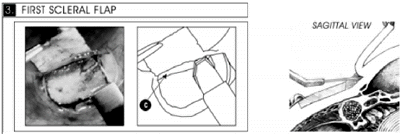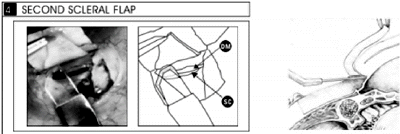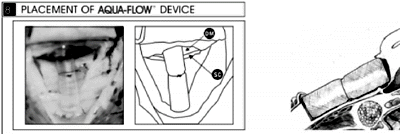Aqua-Flow is effective with speedy recovery
The Aqua-Flow implant prevents scarring of the incision site and lessens the need for glaucoma medications postoperatively, study says.
SEATTLE — Vision is quickly restored and hypotony generally does not occur when using the Aqua-Flow (STAAR Surgical AG, Nidau, Switzerland) collagen implant with deep sclerectomy surgery for glaucoma, according to a study presented by Stephen Bylsma, MD, here at the American Society of Cataract and Refractive Surgery meeting.
Six months postop, patients experienced a decrease in mean intraocular pressure (IOP) of close to 60%.
Although 12-month follow-up data is still being analyzed, Dr. Bylsma expects the 6-month results to be a continuing trend. “The big picture is that because the surgery is non-penetrating, it is a less invasive surgery, recovery is much quicker and it appears that the pressure effect is very comparable to trabeculectomy,” Dr. Bylsma told Ocular Surgery News. “If this procedure is just as effective at lowering pressure as is standard trabeculectomy, but recovery is much quicker, that is a tremendous advantage.”
Rapid healing
The Aqua-Flow collagen implant for glaucoma appears to produce outstanding IOP control without hypotony, antimetabolite modulation or frequent postop visits, Dr. Bylsma said. Recovery of baseline visual acuity was established 1 to 2 weeks after implantation. “Patients are back to seeing with their normal vision and back to activities within 1 week,” Dr. Bylsma said. “This is pretty dramatic compared with a standard trabeculectomy, especially with anti metabolites.” Antimetabolites, such as mitomycin C and 5-fluorouracil, have been used to try to prevent fibrosis.
“The first concern is there is a tendency toward hypotony because they [antimetabolites] prevent healing,” Dr. Bylsma said. “The second thing is we are now finding that more and more with mitomycin C, especially in high concentrations, years later the blebs are too thin and tend to leak in some cases.” No antimetabolites are used with the Aqua-Flow.
In Dr. Bylsma’s study, 6 months following surgery, the average preoperative IOP of 24 mm Hg decreased to a mean average of 14 mm Hg. The mean number of glaucoma medicines used per patient preoperatively was 2.2 and 0.2 post operatively.
“One year data hasn’t been reported yet, but it looks like the trend is very much the same [in terms of IOP reduction],” Dr. Bylsma said. “The patients who had surgery early on have a higher 6-month IOP than the patients who had surgery later. There is definitely a learning curve to this.”
Non-penetrating deep sclerectomy
To insert the Aqua-Flow, a non-penetrating deep sclerectomy (NPDS) is utilized. Once the outer wall of Schlemm’s canal is removed, the inner wall is partially removed with forceps. By putting the collagen device over the remaining trabecular meshwork, scarring is prevented. It takes about 6 to 9 months for the device to be resorbed, leaving a long-lasting outflow channel.
NPDS with the Aqua-Flow may reduce the risk of hypotony, hyphema, choroidal effusion, flat anterior chambers, endophthalmitis and other risks associated with trabeculectomy. Immediately following the surgery, patients experienced less intraocular inflammation when compared with standard trabeculectomy.
Additionally, patients required fewer postoperative IOP-lowering medications. There were no perioperative or postoperative complications directly attributed to the Aqua-Flow implant, Dr. Bylsma said.

Using 0.12 forceps and Westcott scissors, a fornix- or limbal-based peritomy is made. Hemostasis is performed as necessary.

Using either a metal, ruby or diamond blade, a 5x5x5 mm incision is fashioned at approximately 35% scleral thickness.

Starting at either corner, a superficial flap is created by dissecting the sclera approximately 1 mm anteriorly into clear cornea (C). A traction suture can be placed in the flap for greater exposure.

A second deep flap is incised approximately 90% to 95% scleral thickness and dissected anteriorly. As Schlemm’s canal (SC) is approached, longitudinal scleral fibers become more pronounced. After “de-roofing” Schlemm’s canal, the dissection is carried anteriorly, exposing Descemet’s membrane (DM).

The deep scleral flap is excised. Schlemm’s canal is now exposed and its inner wall is visible. It may appear translucent or opaque, depending upon the pigmentation.

With forceps designed by Dr. André Mermoud, the inner wall (IW) of Schlemm’s canal is removed. This, along with the exposed Descemet’s membrane, greatly enhances aqueous outflow.

After sufficient aqueous outflow is established, a 10-0 nylon suture is pre-placed in the scleral bed at midpoint.

The Aqua-Flow device is then sutured into place over Schlemm’s canal and Descemet’s membrane.

The superficial flap is sutured loosely over the device using two 10-0 nylon sutures.

Conjunctiva and Tenon’s capsule is closed using an 8-0 Vicryl suture, producing a watertight seal.
For Your Information:
- Stephen Bylsma, MD, can be reached at P.O. Box 1458, Pismo Beach, CA 93448-1458 U.S.A.; +(1) 805-925-2637; fax: +(1) 805-928-2067. Dr. Bylsma has no direct financial interest in any of the products mentioned in this article. He is a paid consultant for STAAR Surgical.
